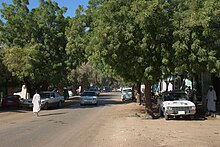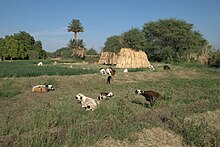Dunqula
Coordinates: 19 ° 10 ′ N , 30 ° 28 ′ E
Dunqula ( Arabic دنقلا Dunqulā ; Sudanese Arabic : Dungulā , alternative spelling Dongola , Dungula, Dongla , rarely Donggola or Donqola ) is the capital of the Sudanese state of Ash-Shamaliyya . Sometimes it is also called New Dongola to distinguishit from Old Dongola .
location
The city is located in the center of Nubia , around 200 kilometers south of Lake Nubia , the Sudanese part of Lake Nasser and 500 kilometers northwest of Khartoum , on the left bank of the Nile .
The road up the Nile to the junction in Abu Dom and further south to Khartoum is paved, as has the road on the eastern side of the Nile via Abri to Wadi Halfa since 2010 . A bridge over the Nile two kilometers north of the city was completed in autumn 2009. Another asphalt road leads east through the desert to Karima . The Dongola Airport is 10 kilometers to the west.
The 275 km long course of the Nile between Dongola and Karima is navigable, until after 1980 passenger ships operated on this route. Because of the cataracts, it is difficult to take a boat to Wadi Halfa, and not possible when the water level is low.
population
13,563 inhabitants (2012 calculation) are given for Dongola. The population is made up of Nubians and Sheygya (Shaqiya) Arabs, whose settlement center is further south. Within the Nubians, the group of the Dongolese, who settle north up to the 3rd cataract, can be distinguished.
| Dunqula | ||||||||||||||||||||||||||||||||||||||||||||||||
|---|---|---|---|---|---|---|---|---|---|---|---|---|---|---|---|---|---|---|---|---|---|---|---|---|---|---|---|---|---|---|---|---|---|---|---|---|---|---|---|---|---|---|---|---|---|---|---|---|
| Climate diagram | ||||||||||||||||||||||||||||||||||||||||||||||||
| ||||||||||||||||||||||||||||||||||||||||||||||||
Population development:
| year | Residents |
|---|---|
| 1973 (census) | 5,626 |
| 1983 (census) | 10.146 |
| 2012 (calculation) | 13,563 |
history
Dongola is a second name for the early medieval Christian kingdom of Makuria , the capital of which was Old Dongola, 80 kilometers upstream. The present city of Dongola was founded in 1812 by a group of Mameluks who fled Egypt from persecution by Muhammad Ali Pasha . The French rule over Egypt, which ended in 1801, weakened the power of the Mamluks. In March 1811, the entire leadership of the Mamluks was murdered in a massacre by the Ottoman viceroy, their families were persecuted and their houses looted. The remaining Mamluks died in 1812 during a campaign by his son Ibrahim Pasha to Upper Egypt, only a few managed to escape beyond the 3rd cataract further south, where they set up a camp on the Nile. The name of the city in the 19th century refers to this: Dongola al Urd ("the camp").
The third son of the Egyptian ruler, Ismail Kamil Pascha, penetrated south from 1820, took the Mamluk settlement of Dongola and ended the rule of the Funj Sultanate in 1821 . The Mamluks had already dispersed before the arrival of the Egyptians, most of them had fled to Shendi . Dongola was deserted, but the Sheygya, an Arab ethnic group south of the city described as freedom-loving and combative, offered vain resistance. The Orient traveler Jean Louis Burckhardt , who had traveled through Dongola in 1814, had feared the robbers of the Sheygya . The aim of the advancing Egyptian army was to eliminate the danger posed by the Mamluks, to gain control of the caravan trade and access to Sudanese gold mines, as well as slaves for the Egyptian army. During this campaign, Old Dongola was completely destroyed. Until 1885, Dongola belonged to the Turkish-Egyptian Sudan as one of the four central provinces (Mudiriya) around Khartoum .

The new Dongola was built and fortified according to plans by the natural scientist Christian Gottfried Ehrenberg . He took part in an expedition of Baron von Minotuli from 1821 to 1823, which led through the Libyan desert and up the Nile via Dongola to the Red Sea . Prince von Pückler-Muskau traveled up the Nile in 1837, where he had to cover the arduous land route from Wadi Halfa in April due to the low water level and bathed in the Nile at Dongola "despite the many crocodiles almost daily". The onward journey took place by ship.
In the middle of the 19th century, the place had around 6000 inhabitants, the fields on the banks of the Nile were irrigated via bucket wheels (Sakiya) and canals. By 1900, Dongola had grown to 8,000 to 10,000 residents. In the 19th century, Dongola was on a pilgrimage route that ran from Darfur in a direct line through the desert, crossed the Nile at Dongola and continued east to the port of Suakin to the ship to Jeddah . Other Hajj Muslims traveled down the Nile from Dongola and joined Egyptian pilgrims in Cairo .
During the final years of the Turkish-Egyptian rule over Sudan, under British influence in the 1870s, a railway was to be built from Egypt to Dongola and on to El Fasher in Darfur. The few kilometers completed by Wadi Halfa along the Nile were only expanded to 54 kilometers in 1896 and discontinued in 1905.
The future Mahdi was born as Muhammad Ahmad in 1844 near Dongola. The city came under his rule ( Mahdiya ) from 1885 to 1896 . The railroad served as a logistical prerequisite for the reconquest of Sudan; the Anglo-Egyptian troops of the Dongola expedition under Kitchener advanced along the Nile and in June 1896 defeated an army of the Mahdi at the Battle of Firket . The division under Archibald Hunter then succeeded in taking Dongola. Hunter was governor of Dongola until 1899 and at the same time commander of the border troops there. As far as Dongola, supplies could be transported on the Nile. From here, the advanced Anglo-Egyptian forces to the decisive battle of Omdurman before, which took place in September 1898th
Cityscape

The city, which is prosperous through trade and agriculture, is separated from the Nubian desert by a wide green belt of irrigated fields . The irrigation canals are fed with Nile water from numerous small diesel pumps instead of the earlier Sakiyas driven by cattle going in circles. In addition to date palms , citrus fruits, vegetables and cereals (wheat) are planted. Sheep and cattle are also kept in pens in the fields.
The chessboard-like city center stretches a few 100 meters from the ferry pier, separated from the bank of the Nile by a strip of farmland. South of the busy market district is a residential area with still partly traditional houses made of rammed earth.
The foundations of the Temple of Kawa were excavated three kilometers away on the eastern bank of the river .
sons and daughters of the town
- Muhammad Ahmad (1844–1885), Islamic political leader
- Jafar an-Numairi (1930–2009), President of Sudan from 1971 to 1985
Others
The Dongola gerbil (Gerbillus dongolanus) is only known from Dongola.
Web links
Individual evidence
- ↑ Sudan Meteorological Authority: Climate Information Dongola. World Meteorological Organization, accessed October 27, 2012 .
- ↑ Archived copy ( Memento of the original dated December 29, 2011 in the Internet Archive ) Info: The archive link was automatically inserted and not yet checked. Please check the original and archive link according to the instructions and then remove this notice. World Gazetteer
- ^ George Waddington, Barnard Hanbury: Journal of a Visit to Some Parts of Ethiopia. John Murray, London 1822, p. 94. As Google books
- ^ Jean Louis Burckhardt : Travels in Nubia. Chapter 1: Journey along the Banks of the Nile, from Assouan to Mahass, on the Frontiers of Dongola. 1814 ebooks.adelaide
- ↑ Quotation in: Peter Milan Jahn: Hermann Fürst von Pückler-Muskau as a writer in Egypt. Cairo German Studies, 2004 ( page no longer available , search in web archives ) Info: The link was automatically marked as defective. Please check the link according to the instructions and then remove this notice.
- ^ Prince Hermann von Pückler-Muskau: From Mehmed Ali's realm. Egypt and Sudan around 1840. 1844. New edition: Manesse Verlag, Zurich 1985
- ↑ Keyword: Dongola. Herders Conversations-Lexikon, Freiburg 1854, Volume 2, p. 430 Zeno.org
- ↑ Keyword: Dongola. Meyers Großes Konversations-Lexikon, Volume 5. Leipzig 1906, p. 113. Zeno.org


